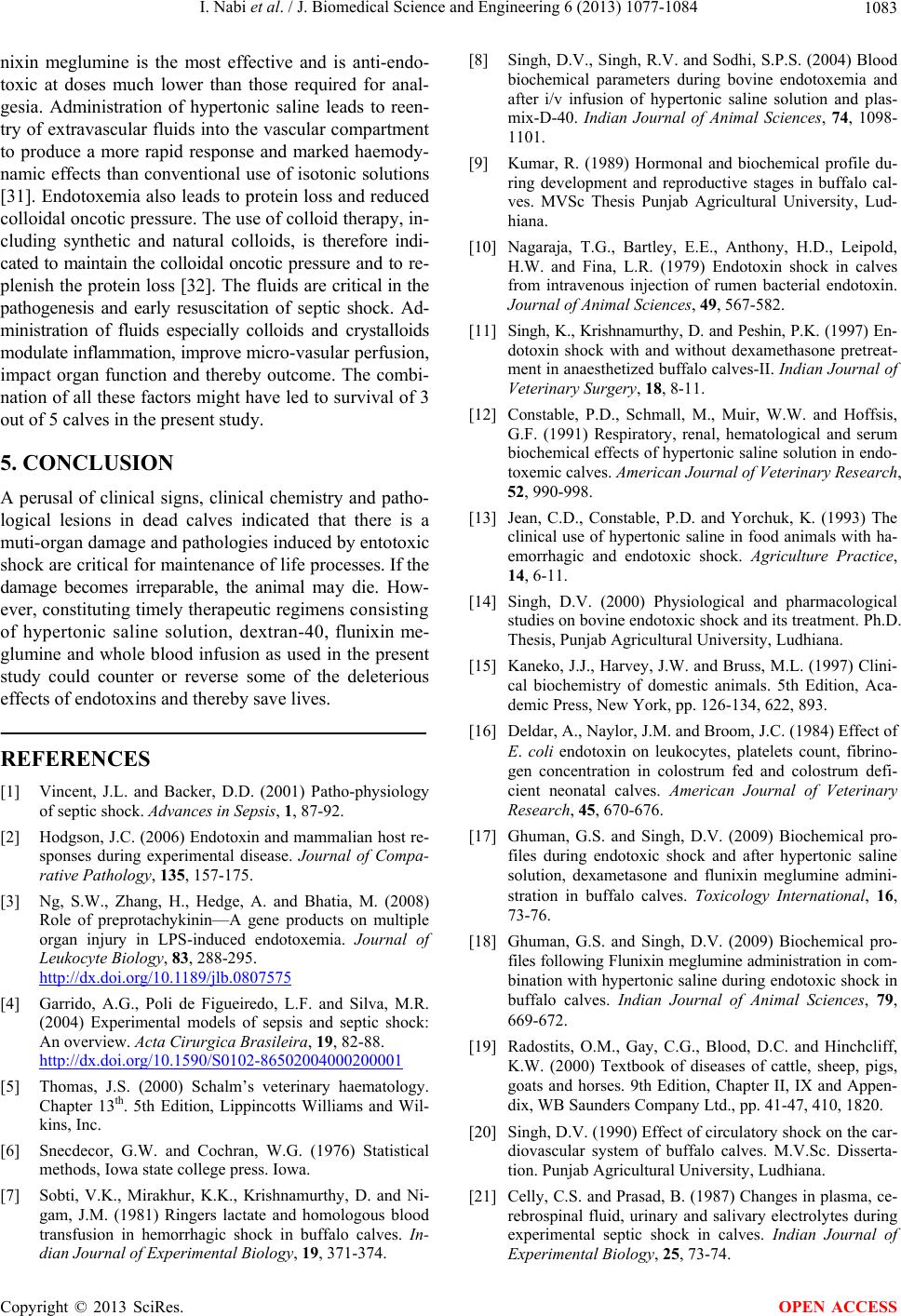
I. Nabi et al. / J. Biomedical Science and Engineering 6 (2013) 1077-1084 1083
nixin meglumine is the most effective and is anti-endo-
toxic at doses much lower than those required for anal-
gesia. Administration of hypertonic saline leads to reen-
try of extravascular fluid s into the vascular compartment
to produce a more rapid response and marked haemody-
namic effects than conventional use of isotonic solutions
[31]. Endotoxemia also leads to protein loss and reduced
colloidal oncotic pressure. The use of colloid therapy, in-
cluding synthetic and natural colloids, is therefore indi-
cated to mainta in the colloidal o ncotic pr ess ure and to r e-
plenish the protein loss [32]. The fluids are critical in the
pathogenesis and early resuscitation of septic shock. Ad-
ministration of fluids especially colloids and crystalloids
modulate inflammation, improve micro - v asu l ar p erf u si on ,
impact organ function and thereby outcome. The combi-
nation of all these factors might have led to survival of 3
out of 5 calves in the present st udy .
5. CONCLUSION
A perusal of clinical signs, clinical chemistry and patho-
logical lesions in dead calves indicated that there is a
muti-organ damage and pathologies induced by entotoxic
shock are critical for maintenance of life processes. If the
damage becomes irreparable, the animal may die. How-
ever, constituting timely therapeu tic regimens co ns is ti n g
of hypertonic saline solution, dextran-40, flunixin me-
glumine and whole blood infusion as used in the present
study could counter or reverse some of the deleterious
effects of endotoxins and th ereby save lives.
REFERENCES
[1] Vincent, J.L. and Backer, D.D. (2001) Patho-physiology
of septic shock. Advances in Sepsis, 1, 87-92.
[2] Hodgson, J.C. (2006) Endotoxin and mammalian host re-
sponses during experimental disease. Journal of Compa-
rative Pathology, 135, 157-175.
[3] Ng, S.W., Zhang, H., Hedge, A. and Bhatia, M. (2008)
Role of preprotachykinin—A gene products on multiple
organ injury in LPS-induced endotoxemia. Journal of
Leukocyte Biology, 83, 288-295.
http://dx.doi.org/10.1189/jlb.0807575
[4] Garrido, A.G., Poli de Figueiredo, L.F. and Silva, M.R.
(2004) Experimental models of sepsis and septic shock:
An overview. Acta Cirurgica Brasileira, 19, 82-88.
http://dx.doi.org/10.1590/S0102-86502004000200001
[5] Thomas, J.S. (2000) Schalm’s veterinary haematology.
Chapter 13th. 5th Edition, Lippincotts Williams and Wil-
kins, Inc.
[6] Snecdecor, G.W. and Cochran, W.G. (1976) Statistical
methods, Iowa state college press. Iowa.
[7] Sobti, V.K., Mirakhur, K.K., Krishnamurthy, D. and Ni-
gam, J.M. (1981) Ringers lactate and homologous blood
transfusion in hemorrhagic shock in buffalo calves. In-
dian Journal of Experimental Biology, 19, 371-374.
[8] Singh, D.V., Singh, R.V. and Sodhi, S.P.S. (2004) Blood
biochemical parameters during bovine endotoxemia and
after i/v infusion of hypertonic saline solution and plas-
mix-D-40. Indian Journal of Animal Sciences, 74, 1098-
1101.
[9] Kumar, R. (1989) Hormonal and biochemical profile du-
ring development and reproductive stages in buffalo cal-
ves. MVSc Thesis Punjab Agricultural University, Lud-
hiana.
[10] Nagaraja, T.G., Bartley, E.E., Anthony, H.D., Leipold,
H.W. and Fina, L.R. (1979) Endotoxin shock in calves
from intravenous injection of rumen bacterial endotoxin.
Journal of Animal Sciences, 49, 567-582.
[11] Singh, K., Krishnamurthy , D. and Peshin, P.K. (1997) En -
dotoxin shock with and without dexamethasone pretreat-
ment in anaesthetized buffalo calves-II. Indian Journal of
Veterinary Surgery, 18, 8-11.
[12] Constable, P.D., Schmall, M., Muir, W.W. and Hoffsis,
G.F. (1991) Respiratory, renal, hematological and serum
biochemical effects of hypertonic saline solution in endo-
toxemic calves. American Journal of Veterinary Research,
52, 990-998.
[13] Jean, C.D., Constable, P.D. and Yorchuk, K. (1993) The
clinical use of hypertonic saline in food animals with ha-
emorrhagic and endotoxic shock. Agriculture Practice,
14, 6-11.
[14] Singh, D.V. (2000) Physiological and pharmacological
studies on bovine endotoxic shock and its treatment. Ph.D.
Thesis, Punjab Agricultural University, Ludhiana.
[15] Kaneko, J.J., Harvey, J.W. and Bruss, M.L. (1997) Clini-
cal biochemistry of domestic animals. 5th Edition, Aca-
demic Press, New York, pp. 126-134, 622, 893.
[16] Deldar, A., Naylor, J.M. and Broom, J.C. (1984) Effect of
E. coli endotoxin on leukocytes, platelets count, fibrino-
gen concentration in colostrum fed and colostrum defi-
cient neonatal calves. American Journal of Veterinary
Research, 45, 670-676.
[17] Ghuman, G.S. and Singh, D.V. (2009) Biochemical pro-
files during endotoxic shock and after hypertonic saline
solution, dexametasone and flunixin meglumine admini-
stration in buffalo calves. Toxicology International, 16,
73-76.
[18] Ghuman, G.S. and Singh, D.V. (2009) Biochemical pro-
files following Flunixin me glumine administration in com-
bination with hypertonic saline during endotoxic shock in
buffalo calves. Indian Journal of Animal Sciences, 79,
669-672.
[19] Radostits, O.M., Gay, C.G., Blood, D.C. and Hinchcliff,
K.W. (2000) Textbook of diseases of cattle, sheep, pigs,
goats and horses. 9th Edition, Chapter II, IX and Appen-
dix, WB Saunders Company Ltd., pp. 41-47, 410, 1820.
[20] Singh, D.V. (1990) Effect of circulatory shock on the car-
diovascular system of buffalo calves. M.V.Sc. Disserta-
tion. Punjab Agricultural University, Ludhiana.
[21] Celly, C.S. and Prasad, B. (1987) Changes in plasma, ce-
rebrospinal fluid, urinary and salivary electrolytes during
experimental septic shock in calves. Indian Journal of
Experimental Biology, 25, 73-74.
Copyright © 2013 SciRes. OPEN ACCESS